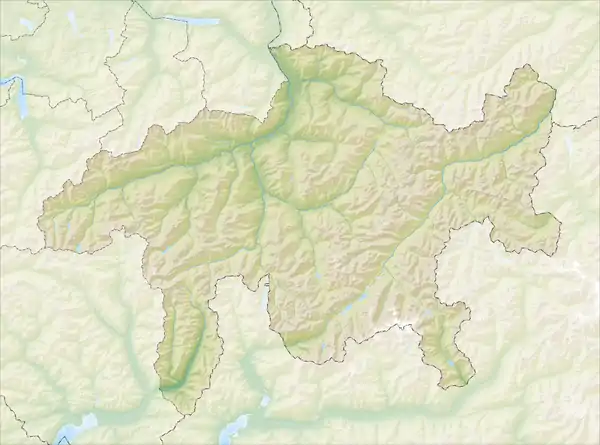Rongellen | |
|---|---|
 Coat of arms | |
Location of Rongellen | |
 Rongellen  Rongellen | |
| Coordinates: 46°40′37″N 9°26′44″E / 46.67694°N 9.44556°E | |
| Country | Switzerland |
| Canton | Graubünden |
| District | Viamala |
| Area | |
| • Total | 2.02 km2 (0.78 sq mi) |
| Elevation | 1,003 m (3,291 ft) |
| Population (31 December 2018)[2] | |
| • Total | 52 |
| • Density | 26/km2 (67/sq mi) |
| Time zone | UTC+01:00 (Central European Time) |
| • Summer (DST) | UTC+02:00 (Central European Summer Time) |
| Postal code(s) | 7430 |
| SFOS number | 3711 |
| Surrounded by | Lohn, Sils im Domleschg, Thusis, Zillis-Reischen |
| Website | www SFSO statistics |
Rongellen is a municipality in the canton of Graubünden in Switzerland, located in the Viamala Region.
History
Rongellen is first mentioned in 1344 as Rungal.[3]
Geography
Rongellen has an area, as of 2006, of 2 km2 (0.77 sq mi). Of this area, 15.2% is used for agricultural purposes, while 63.2% is forested. Of the rest of the land, 5.4% is settled (buildings or roads) and the remainder (16.2%) is non-productive (rivers, glaciers or mountains).[4]
Before 2017, the municipality was located in the Schams sub-district, of the Hinterrhein district, after 2017 it was part of the Viamala Region.[5] It consists of scattered individual farm houses and small groups of houses in a clearing along the old Viamala road.
Demographics
Rongellen has a population (as of 31 December 2020) of 56.[6] As of 2008, 11.1% of the population was made up of foreign nationals. Over the last 10 years the population has decreased at a rate of -4.3%.[4]
As of 2000, the gender distribution of the population was 53.3% male and 46.7% female.[7] The age distribution, as of 2000, in Rongellen is; 2 people or 3.8% of the population are between 0 and 9 years old. 2 people or 3.8% are 10 to 14, and 11 people or 20.8% are 15 to 19. Of the adult population, 8 people or 15.1% of the population are between 20 and 29 years old. 7 people or 13.2% are 30 to 39, 5 people or 9.4% are 40 to 49, and 8 people or 15.1% are 50 to 59. The senior population distribution is 2 people or 3.8% of the population are between 60 and 69 years old, 7 people or 13.2% are 70 to 79, there is 1 person or 1.9% who is 80 to 89.[8]
In the 2007 federal election the most popular party was the SVP which received 65.6% of the vote. The next two most popular parties were the FDP (11.1%) and the CVP (10%).[4]
In Rongellen about 69.6% of the population (between age 25–64) have completed either non-mandatory upper secondary education or additional higher education (either university or a Fachhochschule).[4]
Rongellen has an unemployment rate of 4.8%. As of 2005, there were 3 people employed in the primary economic sector and about 1 business involved in this sector. No one is employed in the secondary sector and there are no businesses in this sector. 3 people are employed in the tertiary sector, with 1 business in this sector.[4]
The historical population is given in the following table:[3]
| year | population |
|---|---|
| 1780 | 75 |
| 1850 | 63 |
| 1900 | 49 |
| 1950 | 71 |
| 2000 | 53 |
Languages
Most of the population (as of 2000) speaks German (88.7%), with Romansh being second most common ( 9.4%) and Klaf being third (sdja%).[4]
| Languages in Rongellen | ||||||
| Languages | Census 1980 | Census 1990 | Census 2000 | |||
| Number | Percent | Number | Percent | Number | Percent | |
| German | 28 | 87.50% | 45 | 93.75% | 47 | 88.68% |
| Romanish | 3 | 9.38% | 1 | 2.08% | 5 | 9.43% |
| Population | 32 | 100% | 48 | 100% | 53 | 100% |
References
- ↑ "Arealstatistik Standard - Gemeinden nach 4 Hauptbereichen". Federal Statistical Office. Retrieved 13 January 2019.
- ↑ "Ständige Wohnbevölkerung nach Staatsangehörigkeitskategorie Geschlecht und Gemeinde; Provisorische Jahresergebnisse; 2018". Federal Statistical Office. 9 April 2019. Retrieved 11 April 2019.
- 1 2 Rongellen in German, French and Italian in the online Historical Dictionary of Switzerland.
- 1 2 3 4 5 6 Swiss Federal Statistical Office accessed 7 October 2009
- ↑ Swiss Federal Statistical Office - Amtliches Gemeindeverzeichnis der Schweiz - Mutationsmeldungen 2016 accessed 16 February 2017
- ↑ "Ständige und nichtständige Wohnbevölkerung nach institutionellen Gliederungen, Geburtsort und Staatsangehörigkeit". bfs.admin.ch (in German). Swiss Federal Statistical Office - STAT-TAB. 31 December 2020. Retrieved 21 September 2021.
- ↑ Graubunden in Numbers Archived 2009-09-24 at the Wayback Machine (in German) accessed 21 September 2009
- ↑ Graubunden Population Statistics Archived 2009-08-27 at the Wayback Machine (in German) accessed 21 September 2009